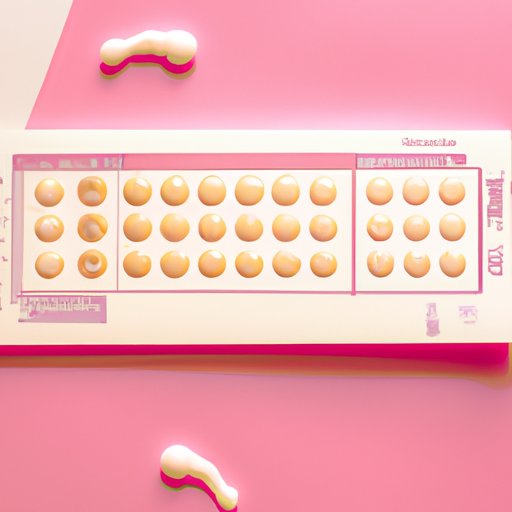Introduction
Hormonal birth control, also known as hormonal contraception, is a type of contraception used to prevent pregnancy. It works by stopping ovulation, which is the process in which a woman’s body releases an egg that can be fertilized by sperm. By preventing ovulation, hormonal birth control prevents pregnancy. There are many different types of hormonal birth control available, and this article will explore how they work and the potential side effects of using them.
Types of Hormonal Birth Control and How They Work
There are several different types of hormonal birth control, each of which works differently to prevent pregnancy. The most common type of hormonal birth control is combination birth control pills, which contain both estrogen and progestin. These hormones stop ovulation and thicken cervical mucus, making it difficult for sperm to reach an egg. Another type of hormonal birth control is progestin-only pills, which only contain progestin. These pills also stop ovulation and thicken cervical mucus.
The patch is another form of hormonal birth control that contains both estrogen and progestin. The patch is placed on the skin and slowly releases hormones into the bloodstream. The hormones prevent ovulation and thicken cervical mucus. Vaginal rings are another type of hormonal birth control. They are inserted into the vagina and slowly release hormones. These hormones prevent ovulation and thicken cervical mucus. Implants are small rods that are inserted under the skin and slowly release hormones. These hormones prevent ovulation and thicken cervical mucus. Finally, injections are shots of hormones that are given every three months. These hormones prevent ovulation and thicken cervical mucus.

Examining the Science Behind How Hormones Affect Fertility
In order to understand how hormonal birth control works, it is important to understand how hormones affect fertility. Hormones are chemical messengers in the body that help regulate various processes, including fertility. The two main hormones involved in fertility are estrogen and progesterone. Estrogen helps prepare the uterus for pregnancy, while progesterone helps maintain the uterine lining during pregnancy.
These hormones work together to regulate the menstrual cycle. During the follicular phase, estrogen levels rise and cause the uterine lining to thicken. This prepares the uterus for a possible pregnancy. During the luteal phase, progesterone levels rise and cause the uterine lining to thicken further. This helps maintain the uterine lining if a pregnancy occurs. If no pregnancy occurs, the uterine lining is shed during menstruation.
Hormonal birth control works by disrupting the normal balance of hormones in the body. By introducing synthetic hormones into the body, these hormones can either stop or delay ovulation. This prevents pregnancy by preventing the release of an egg that could be fertilized by sperm. Additionally, the hormones can also thicken cervical mucus, which makes it more difficult for sperm to reach an egg.

Investigating Potential Side Effects of Using Hormonal Birth Control
While hormonal birth control is generally safe and effective, there are some potential side effects associated with its use. Common side effects include nausea, headaches, breast tenderness, weight gain, and mood changes. These side effects are usually mild and can be managed with lifestyle changes or over-the-counter medications. However, there are some serious side effects associated with hormonal birth control, such as increased risk of blood clots, stroke, and heart attack. Women who have certain medical conditions, such as high blood pressure or diabetes, should talk to their doctor before using hormonal birth control.
Discussing Different Methods of Delivery for Hormonal Contraception
There are several different methods of delivery for hormonal contraception. Oral contraceptives, or “the pill”, are taken daily and contain both estrogen and progestin. Transdermal patches are placed on the skin and slowly release hormones into the bloodstream. Vaginal rings are inserted into the vagina and slowly release hormones. Implants are small rods that are inserted under the skin and slowly release hormones. And finally, injections are shots of hormones that are given every three months.

Looking at Benefits and Risks of Using Hormonal Birth Control
When considering whether or not to use hormonal birth control, it is important to weigh the benefits and risks. On the one hand, hormonal birth control is highly effective at preventing pregnancy when used correctly. It is also convenient and discreet, and can be used to manage certain medical conditions, such as endometriosis or polycystic ovarian syndrome. On the other hand, there are potential risks associated with using hormonal birth control, such as an increased risk of blood clots, stroke, and heart attack. Additionally, some women may experience side effects, such as headaches, nausea, or mood changes.
Conclusion
In conclusion, hormonal birth control is an effective method of contraception that can be used to prevent pregnancy. There are several different types of hormonal birth control available, and each works differently to prevent ovulation and thicken cervical mucus. Understanding the science behind how hormones affect fertility can help explain how hormonal birth control works. Additionally, there are potential side effects associated with using hormonal birth control, and it is important to weigh the benefits and risks before deciding if it is right for you.
Summary of Article
This article explored how does hormonal birth control work, examining the types of contraception available, discussing the science behind hormones and fertility, looking at potential side effects, and comparing the benefits and risks of using hormonal contraceptives.
Final Thoughts
Hormonal birth control is an effective method of contraception that can be used to prevent pregnancy. It is important to understand how it works and the potential side effects before deciding if it is right for you. Talk to your doctor about your options and make an informed decision about which type of hormonal birth control is best for you.
(Note: Is this article not meeting your expectations? Do you have knowledge or insights to share? Unlock new opportunities and expand your reach by joining our authors team. Click Registration to join us and share your expertise with our readers.)
